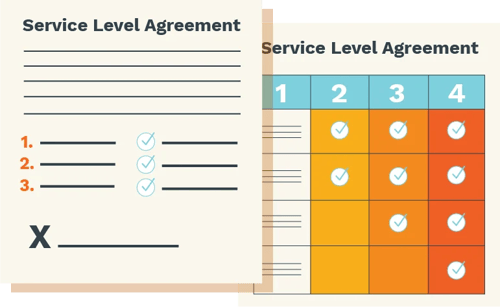In our years of experience in managed IT services, we’re always shocked by the number of clients who seek out managed IT partnerships without giving due thought to the Service Level Agreements (SLAs) that come along with them.
.webp?width=300&height=432&name=Office1%20SLA%20Blog%20Graphic01%20(1).webp)
This is a problem. It’s hard for us to overstate the importance of the SLA. Your SLA defines your relationship with your managed service provider; it makes clear all roles and responsibilities in a partnership while supplying a structured framework that guarantees profitability for both parties.
As such, it’s in your best interest to take an active approach in developing your SLA by making sure the agreement contains all the information you’ll need to hold your managed services provider accountable.
What To Include In The SLA
SLAs should be created early in your partnership and should be as specific as possible. At the minimum, make sure your SLA includes the following elements:
- Service definitions: First and foremost, the SLA should include the list of products or services being supplied. While relatively straightforward, you may need to create supplementary SLAs for specific services offered by your service provider.
- Obligations: The responsibilities of each party should be clearly set forth, including ongoing support, maintenance, and troubleshooting. This will create structure around what is expected from each party and what specific issues require intervention.

- Reporting responsibilities: The SLA should establish clear reporting responsibilities and guidelines for service assessment. Make sure you know when to report problems, how to determine the severity of each issue, and which channels should be used to communicate this information to the provider.
- Response time: A critical piece of the SLA is defining an acceptable window for service response. This means defining how quickly a provider should respond to a complaint, response times during non-working hours compared to working hours, and how many technicians will be allotted for each event.
- Contingencies: Should a service provider fail to deliver, the SLA should outline clear action steps the provider will take to rectify the situation.
- Termination: The SLA should include a termination clause that details specific circumstances in which the agreement can be canceled. Make sure this section outlines the legal procedures necessary to create a smooth transition.
Revising Your SLA
It is important that both the client and service provider periodically review their SLA. An SLA should be viewed as a complex agreement that can be reviewed when/if the following occur:
- Add/stop offering a service: Whenever your company adds or stops offering a service, the SLA should be revisited in order to maintain current productivity levels in light of the new circumstances.
- The work environment has changed: Your company’s work environment is destined to change with new hires and different technologies. It is essential that your SLA accurately reflects your work environment through all of its changes.
- Advancements in technology: If new technology allows your company to enhance communication or improve customer service, an updated SLA should display that.
- Regular Revisions: It is important to revise your SLA every 18 to 24 months to make sure that inaccurate or old information isn’t portrayed in the agreement.
.webp?width=400&height=384&name=Office1%20SLA%20Blog%20Graphic03%20(1).webp)
It is crucial that these expectations are communicated early on in a partnership so that both parties retain a full understanding of the agreement. Like any relationship, the ability to address and resolve problems strengthens the long-term value of it.
What a Bad SLA Looks Like
There are many ways to misuse an SLA. First, the SLA should not be a replacement for communication between parties. If there are any issues or complaints, it should be dealt with first while using the SLA as a final expedient. Also, a poor SLA is based off of a typical cookie-cutter template and does not represent the unique needs of the company. The failure to address these individual needs can later cause miscommunication between IT providers and their clients. Last, a bad SLA contains false hopes and promises that an IT provider is not actually able to provide. While it is important to sound reliable and promising, not being able to deliver on statements can be detrimental to a client.
Prioritize Your SLA
Make your SLA a priority in your organization, and make sure there are clear definitions, obligations, and contingencies detailed for each service offered.
Remember, your SLA is more than just a list of services you’re receiving. Your SLA is the contract between your company and your service provider. It’s your legal guarantee that your service provider will adhere to the same standards of quality that your customers have come to expect from your brand. Don’t let them down.
Categories: Managed Services











